Optimization of Process Parameters for Carbon Fiber Reinforced Polyamide 6 Composites Fabricated by Self-Resistance Electric Heating Technology
Abstract
:1. Introduction
2. Experiments
2.1. Used Materials
2.2. Manufacturing of CF/PA 6 Composite Laminate
2.3. Determination of Process Parameters
2.4. Determination of Cooling Rate
2.5. Characterizations
2.5.1. Currents and Corresponding Temperature Uniformity
2.5.2. Impregnation Quality
2.5.3. Crystallization Properties
2.5.4. Mechanical Properties Tests
2.5.5. Microscopic Morphology Observation
3. Results and Discussion
3.1. Currents and Corresponding Temperature Uniformity
3.2. The Effect of Process Parameters on Forming Quality
3.2.1. The Effect of Process Parameters on Void Content
3.2.2. The Effect of Process Parameters on Flexural Properties
3.2.3. The Effect of Process Parameters on Impact Properties
3.3. The Effect of Cooling Rate on Properties
3.3.1. The Effect of Cooling Rate on Crystallization Behavior
3.3.2. The Effect of Cooling Rate on Impact Properties
4. Conclusions
- The increasing of parameters (et al., molding temperature, molding pressure, and impregnation time) favors matrix flowing and fiber impregnation, leading to lower void content. However, high molding temperature and long impregnation time can weaken the impregnation effects on laminates. On the other hand, increasing three parameters contributes to higher flexural properties, including flexural strength and flexural modulus, but shows insignificant effects on impact properties. Under this technological process, the optimal set of process parameters is selected as a forming temperature of 270 °C, a forming pressure of 2.5 MPa, and an impregnation of 15 min.
- The XRD analyses reveal that with the cooling rate decrease from 29.56 °C/min to 2.64 °C/min, the crystallization of PA 6 laminates improves from 25.97% to 37.22%. This trend corresponds with the variation trend of α-phase content in the matrix.
- The peak force of the sample at the test temperature of 25 °C and 100 °C is decreased by 23.22 N and 32.79 N, respectively, with the decrease in the cooling rate. Moreover, both reducing the cooling rate and raising the test temperature can have a positive effect on the energy absorbed by the sample. It can be obtained that the lower cooling rate contributes to poorer impact properties, while the higher test temperature in the QSI can improve impact properties.
Author Contributions
Funding
Institutional Review Board Statement
Data Availability Statement
Acknowledgments
Conflicts of Interest
References
- Friedrich, K.; Almajid, A.A. Manufacturing aspects of advanced polymer composites for automotive applications. Appl. Compos. Mater. 2013, 20, 107–128. [Google Scholar] [CrossRef]
- Britnell, D.J.; Cain, R.; Coates, R. An Introduction to Automotive Composites; Rapra Technology Ltd.: Shrewsbury, UK, 2002; pp. 77–89. [Google Scholar]
- Chang, I.; Lees, J. Recent Development in thermoplastic composites: A review of matrix systems and processing methods. J. Thermoplast. Compos. Mater. 1998, 1, 277–296. [Google Scholar] [CrossRef]
- Sakaguchi, M.; Nakai, A.; Hamada, H. Composites Science and Technology. Compos. Sci. Technol. 2000, 60, 717–722. [Google Scholar] [CrossRef]
- Vaidya, U.K.; Chawla, K.K. Processing of fiber reinforced thermoplastic composites. Int. Mater. Rev. 2008, 53, 185–218. [Google Scholar] [CrossRef]
- Tatsuno, D.; Yoneyama, T.; Kawamoto, K.; Okamoto, M. Hot press forming of thermoplastic CFRP sheets. Procedia Manuf. 2018, 15, 1730–1737. [Google Scholar] [CrossRef]
- Liu, X.; Yang, B.; Lu, L.; Wan, Z.; Tang, Y. A Thermoplastic multilayered carbon-fabric/polycarbonate laminate prepared by a two-step hot-press technique. Polymers 2018, 10, 720. [Google Scholar] [CrossRef]
- Trende, A.; Åström, B.T.; Wöginger, A.; Mayer, C.; Neitzel, M. Modelling of heat transfer in thermoplastic composites manufacturing: Double-belt press lamination. Compos. Part A Appl. Sci. Manuf. 1999, 30, 935–943. [Google Scholar] [CrossRef]
- Wang, X.; Mayer, C.; Neitzel, M. Some issues on impregnation in manufacturing of thermoplastic composites by using a double belt press. Polym. Compos. 1997, 18, 701–710. [Google Scholar] [CrossRef]
- Mayer, C.; Wang, X.; Neitzel, M. Macro- and micro-impregnation phenomena in continuous manufacturing of fabric reinforced thermoplastic composites. Compos. Part A Appl. Sci. Manuf. 1998, 29, 783–793. [Google Scholar] [CrossRef]
- Campbell, F.C. Metal-Matrix Composites. In Manufacturing Technology for Aerospace Structural Materials; ASM International: Almere, The Netherlands, 2006; pp. 419–457. [Google Scholar] [CrossRef]
- Davé, R.S.; Henne, M.; Louis, B.; Ermanni, P. Processing: Autoclave Modeling. In Wiley Encyclopedia of Composites; John Wiley Sons, Ltd.: Hoboken, NJ, USA, 2011; pp. 1–13. [Google Scholar] [CrossRef]
- Geyer, A.; Koslowski, T.; Bonten, C. Influence of the heating process on the mechanical properties of continuous reinforced thermoplastics. AIP Conf. Proc. 2016, 1779, 090005. [Google Scholar] [CrossRef]
- Linn, C.; Hoffmann, L.; Müller, T.; Drummer, D. Herstellung von CFK-Bauteilen durch Direktimprägnierung mit Thermoplasten in der Spritzgießmaschine. Lightweight Des. 2012, 53, 56–61. [Google Scholar] [CrossRef]
- Lee, J.; Ni, X.; Daso, F.; Xiao, X.; King, D.; Gómez, J.S.; Varela, T.B.; Kessler, S.; Wardle, B.L. Advanced carbon fiber composite out-of-autoclave laminate manufacture via nanostructured out-of-oven conductive curing. Compos. Sci. Technol. 2018, 166, 150–159. [Google Scholar] [CrossRef]
- Hayes, S.A.; Lafferty, A.D.; Altinkurt, G.; Wilson, P.R.; Collinson, M.; Duchene, P. Direct electrical cure of carbon fiber composites. Adv. Manuf. Polym. Compos. Sci. 2015, 1, 112–119. [Google Scholar] [CrossRef]
- Athanasopoulos, N.; Koutsoukis, G.; Vlachos, D.; Kostopoulos, V. Temperature uniformity analysis and development of open lightweight composite molds using carbon fibers as heating elements. Compos. Part B Eng. 2013, 50, 279–289. [Google Scholar]
- Joseph, C.; Viney, C. Electrical resistance curing of carbon-fibre/epoxy composites. Compos. Sci. Technol. 2000, 60, 315–319. [Google Scholar] [CrossRef]
- Zhang, K.M.; Gu, Y.Z.; Li, M.; Wang, S.K.; Zhang, Z.G. Resistive heating of carbon fiber aided rapid curing of vacuum assisted resin infusion molding. Adv. Mater. Res. 2014, 1030, 170–173. [Google Scholar] [CrossRef]
- Xu, X.; Zhang, Y.; Jiang, J.; Wang, H.; Zhao, X.; Li, Q.; Lu, W. In-situ curing of glass fiber reinforced polymer composites via resistive heating of carbon nanotube films. Compos. Sci. Technol. 2017, 149, 20–27. [Google Scholar] [CrossRef]
- Liu, S.; Li, Y.; Shen, Y.; Lu, Y. Mechanical performance of carbon fiber/epoxy composites cured by self-resistance electric heating method. Int. J. Adv. Manuf. Technol. 2019, 103, 3479–3493. [Google Scholar] [CrossRef]
- Enoki, S.; Iwamto, K.; Harada, R.; Tanaka, K.; Katayama, T. Heating properties of carbon fibers by using direct resistance heating. WIT Trans. Built Environ. 2012, 124, 239–248. [Google Scholar] [CrossRef]
- Enoki, S.; Moriito, K.; Tanaka, K.; Katayama, T. CFRTP molding method of the three-dimensional shape by using direct resistance heating to carbon fiber. High Perform. Opt. Des. Struct. Mater. 2014, 137, 273–287. [Google Scholar] [CrossRef]
- Reese, J.; Vorhof, M.; Hoffmann, G.; Böhme, K.; Cherif, C. Joule heating of dry textiles made of recycled carbon fibers and PA 6 for the series production of thermoplastic composites. J. Eng. Fibers Fabr. 2020, 15, 1558925020905828. [Google Scholar] [CrossRef]
- Wang, X.; Liu, Y.; He, Q.; Weng, C.; Zhai, Z. Fabrication of continuous carbon fiber reinforced polyamide 6 composites by means of self-resistance electric heating. Polym. Compos. 2021, 42, 5962–5974. [Google Scholar] [CrossRef]
- Chung, D.D.L. Processing-structure-property relationships of continuous carbon fiber polymer-matrix composites. Mater. Sci. Eng. 2017, 113, 1–29. [Google Scholar] [CrossRef]
- Lu, C.; Xu, N.; Zheng, T.; Zhang, X.; Lv, H.; Lu, X.; Xiao, L.; Zhang, D. The Optimization of Process Parameters and Characterization of High-Performance CF/PEEK Composites Prepared by Flexible CF/PEEK Plain Weave Fabrics. Polymers 2018, 11, 53. [Google Scholar] [CrossRef] [PubMed]
- Ischida, O.; Kitada, J.; Nunotani, K.; Uzawa, K. Layered self-resistance electric heating to cure thick carbon fiber reinforced epoxy laminates. Polym. Compos. 2021, 30 (Suppl. S1), 39–58. [Google Scholar] [CrossRef]
- Zhang, B.; Li, Y.; Liu, S.; Shen, Y.; Hao, X. Layered self-resistance electric heating to cure thick carbon fiber reinforced epoxy laminates. Appl. Compos. Mater. 2021, 42, 2469–2483. [Google Scholar] [CrossRef]
- Taketa, I.; Kalinka, G.; Gorbatikh, L.; Lomovb, S.V.; Verpoest, I. Influence of cooling rate on the properties of carbon fiber unidirectional composites with polypropylene, polyamide 6, and polyphenylene sulfide matrices. Adv. Compos. Mater. 2020, 29, 101–113. [Google Scholar] [CrossRef]
- Ono, M.; Yamane, M.; Tanoue, S.; Uematsu, H.; Yamashita, Y. Mechanical Properties of Thermoplastic Composites Made of Commingled Carbon Fiber/Nylon Fiber. Polymers 2021, 13, 3206. [Google Scholar] [CrossRef]
- Zhang, Y.; Sun, L.; Li, L.; Wei, J. Effects of strain rate and high temperature environment on the mechanical performance of carbon fiber reinforced thermoplastic composites fabricated by hot press molding. Compos. Part A Appl. Sci. Manuf. 2020, 134, 105905. [Google Scholar] [CrossRef]
- D2734/D2734M-03; Standard Test Methods for Void Content of Reinforced Plastics. ASTM American Society of Testing Materials; ASTM International: West Conshohocken, PA, USA, 2003.
- D7264/D7264M-15; Standard Test Method for Flexural Properties of Polymer Matrix Composite Materials. ASTM American Society of Testing Materials; ASTM International: West Conshohocken, PA, USA, 2015.
- D6264/D6264M-12; Standard Test Method for Measuring the Damage Resistance of a Fiber-Reinforced Polymer-Matrix Composite to a Concentrated Quasi-Static Indentation Force. ASTM American Society of Testing Materials; ASTM International: West Conshohocken, PA, USA, 2012.
- Ito, M.; Mizuochi, K.; Kanamoto, T. Effects of crystalline forms on the deformation behaviour of nylon-6. Polymer 1998, 39, 4593–4598. [Google Scholar] [CrossRef]
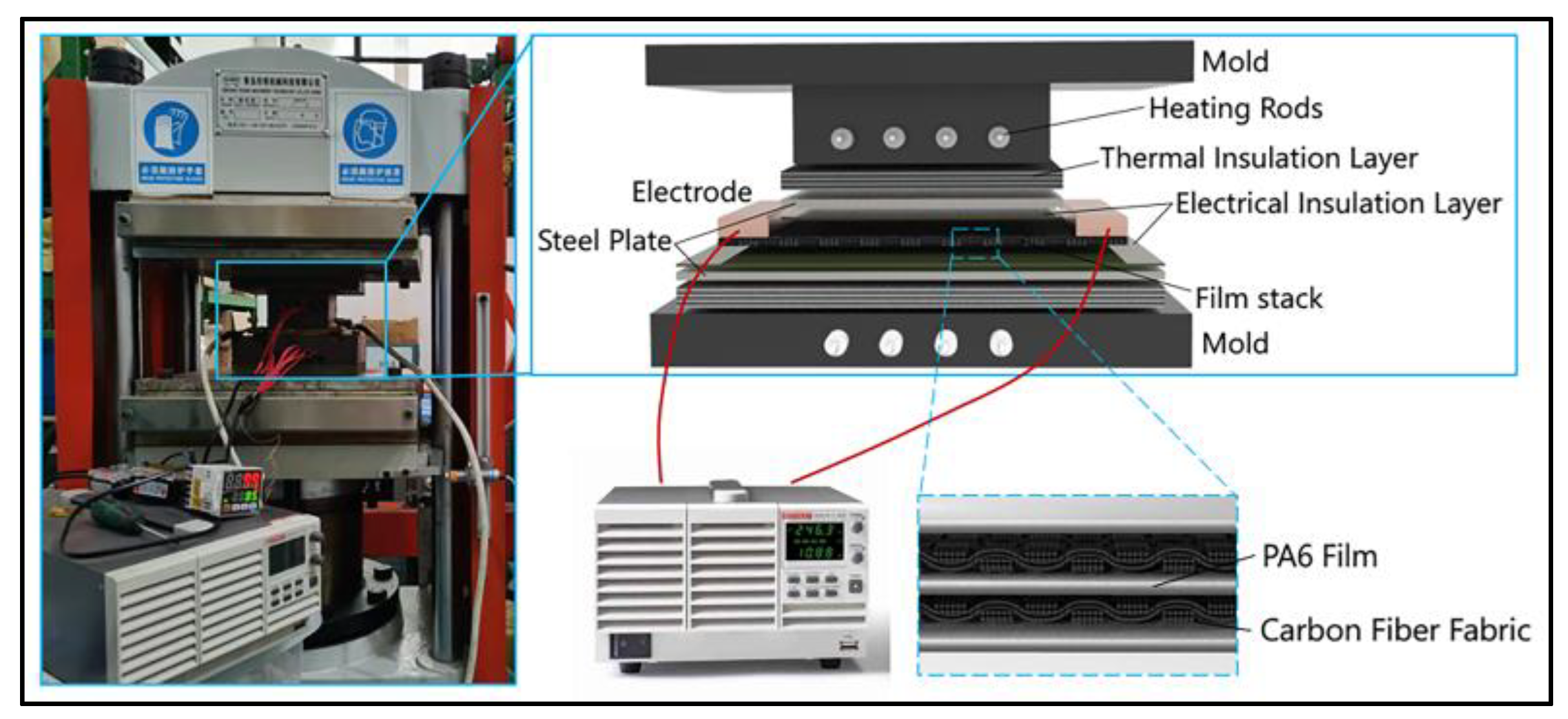

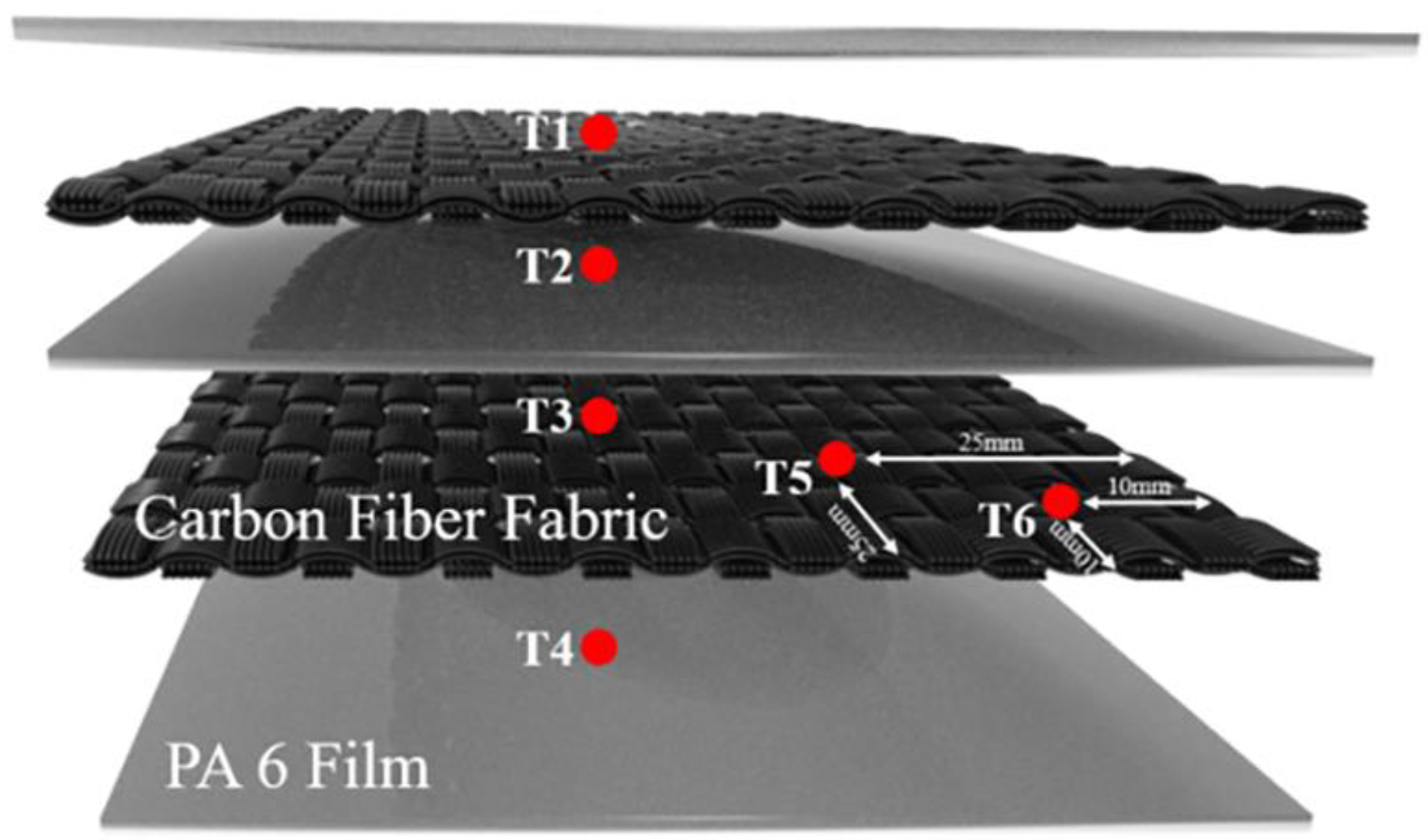

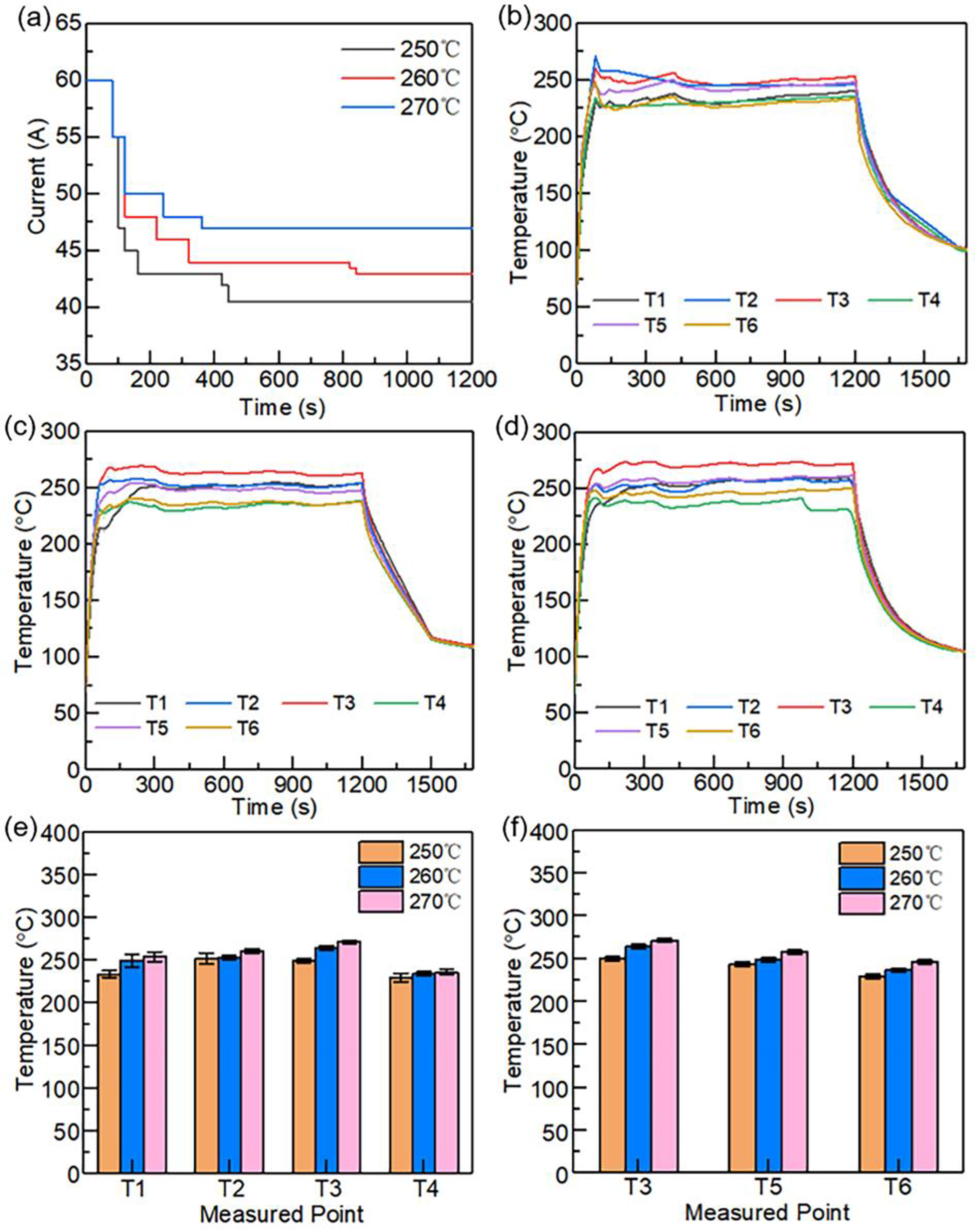
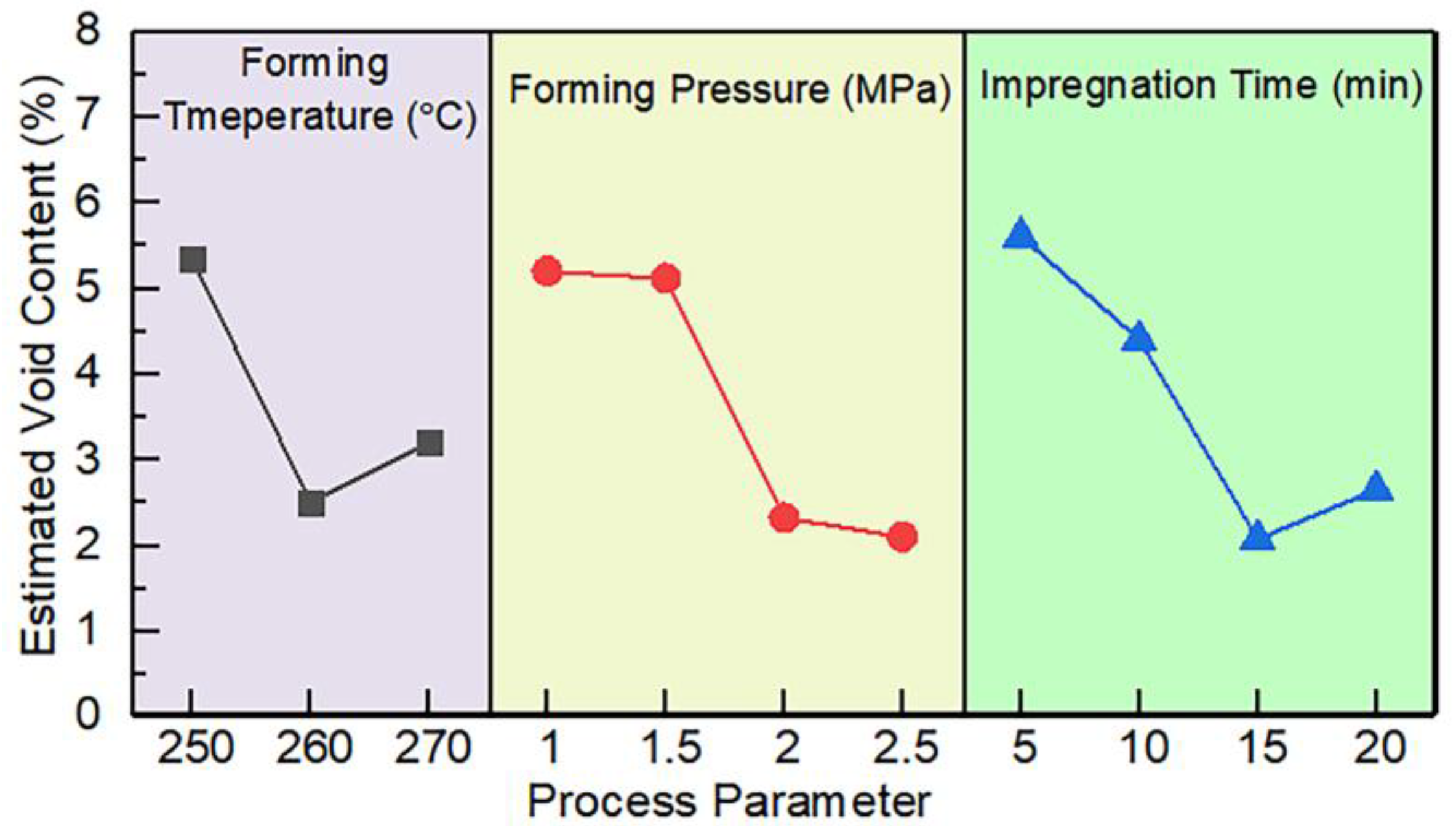
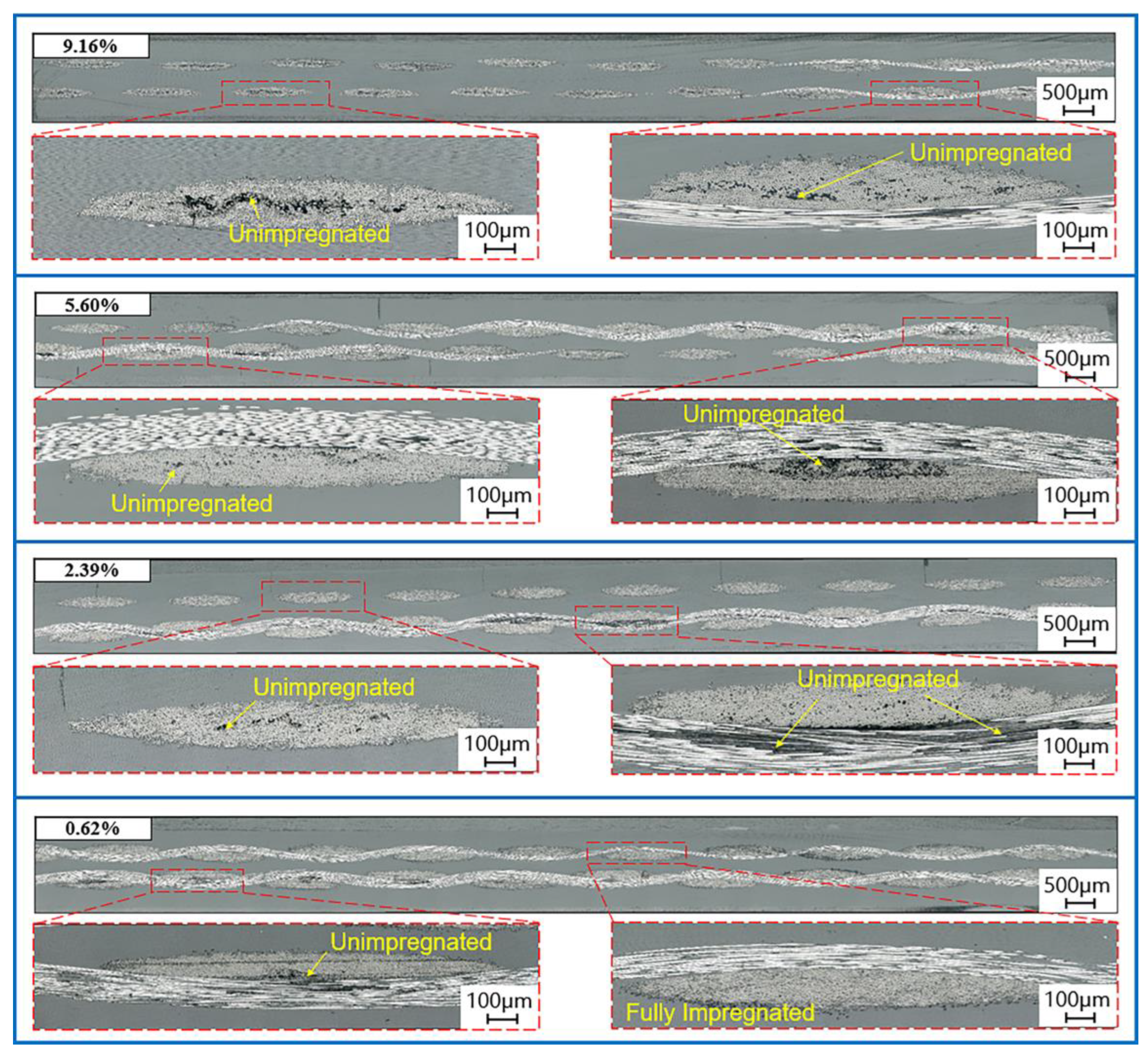
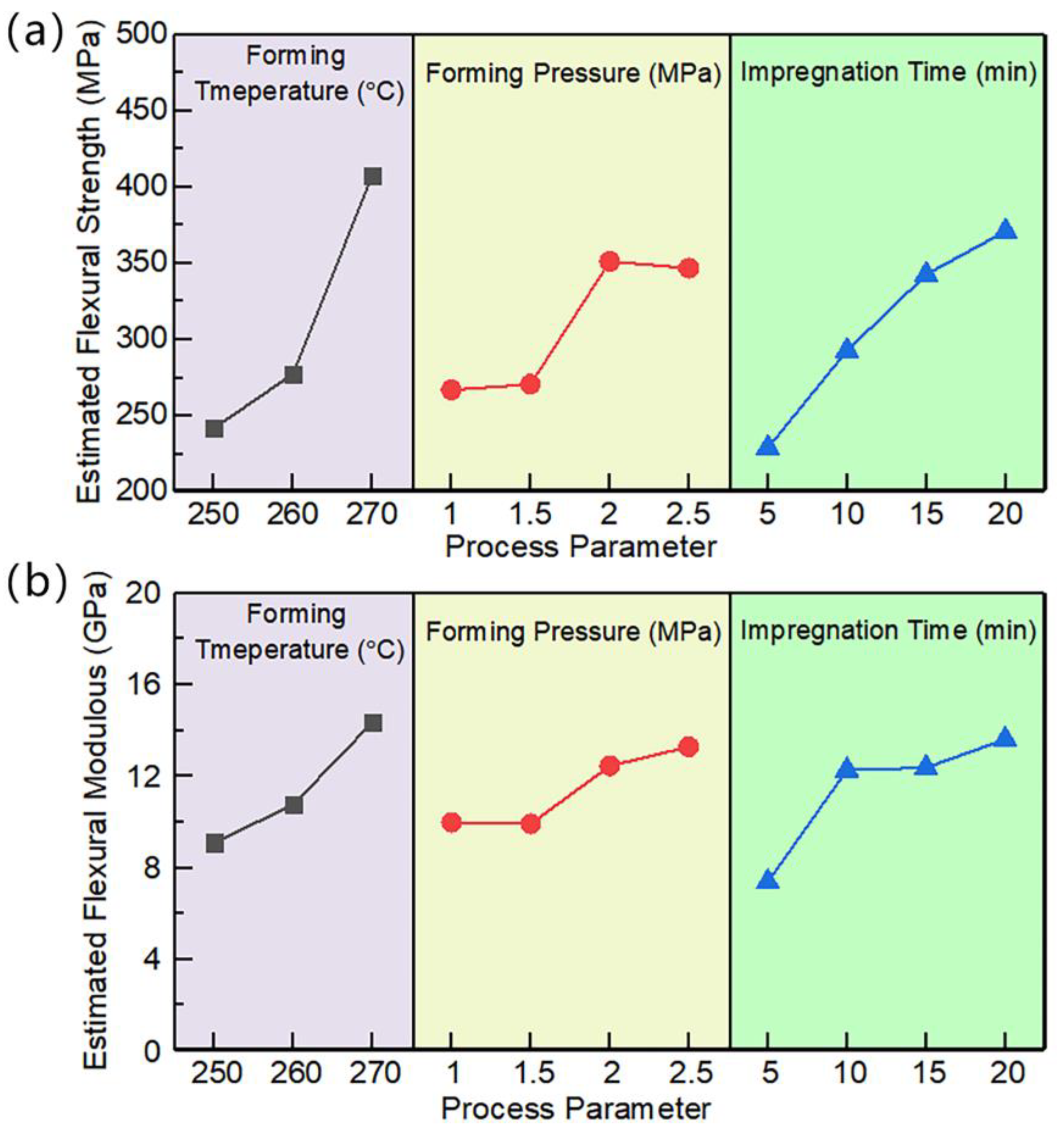
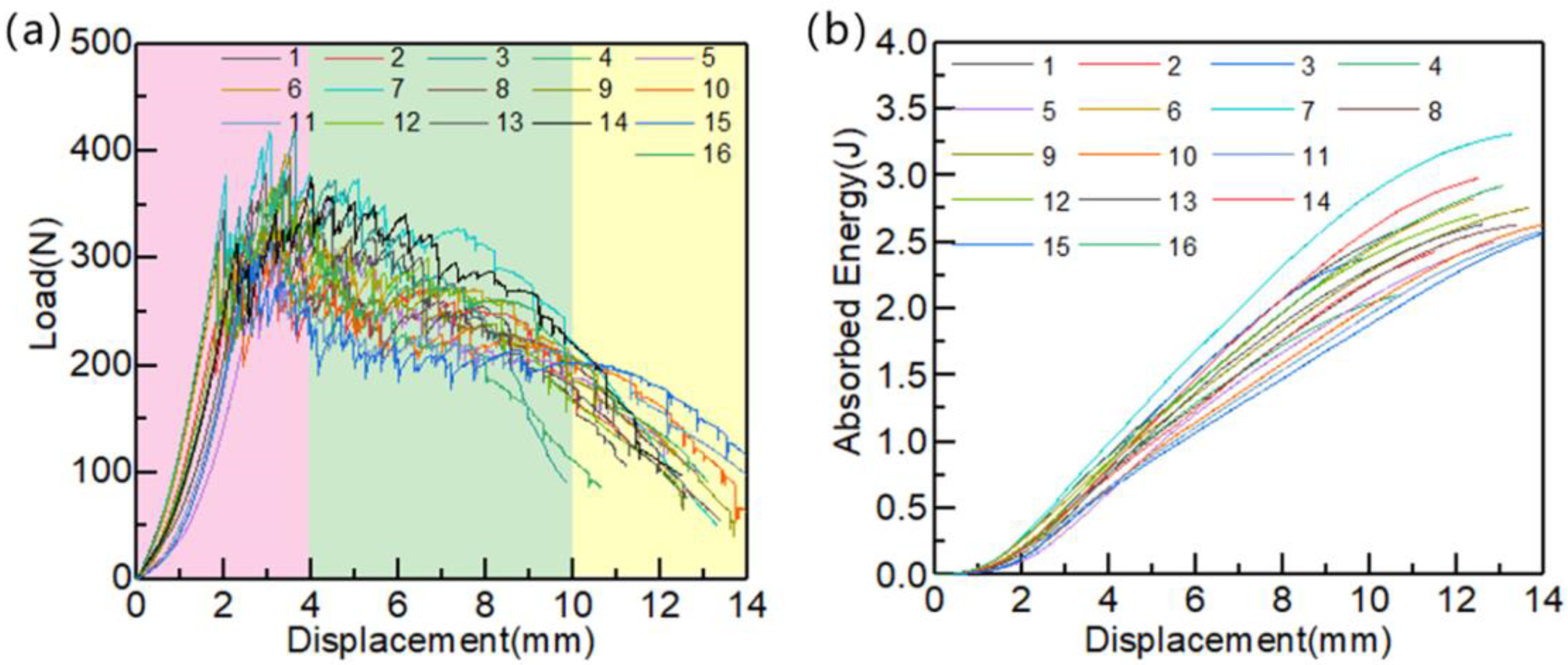

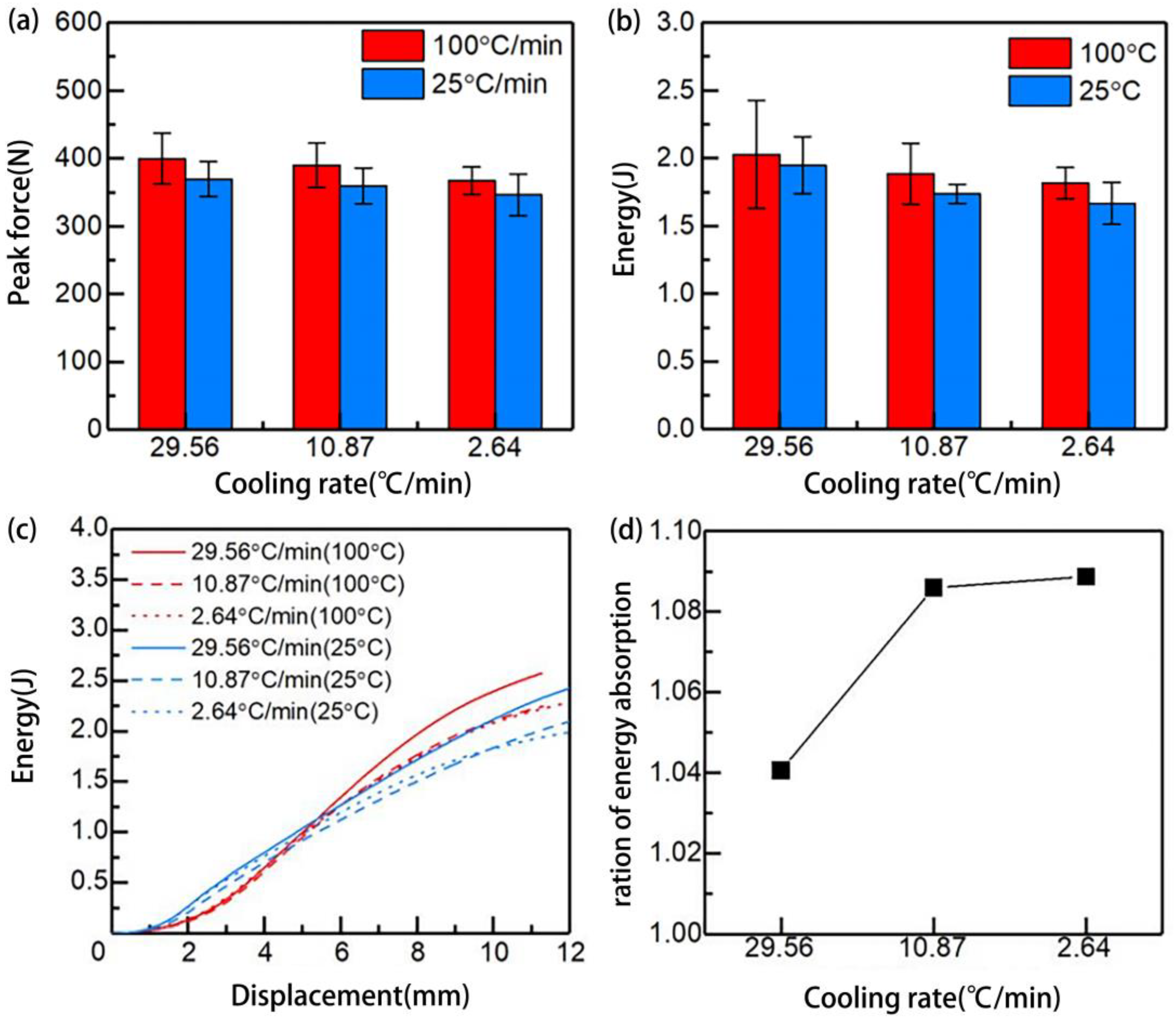

| Exp. ID | Processing Temperature (°C) | Forming Pressure (MPa) | Impregnation Time (min) |
|---|---|---|---|
| 1 | 250 | 2.5 | 20 |
| 2 | 260 | 1.0 | 20 |
| 3 | 250 | 1.0 | 5 |
| 4 | 270 | 1.5 | 5 |
| 5 | 250 | 2.0 | 5 |
| 6 | 260 | 2.5 | 5 |
| 7 | 250 | 2.0 | 15 |
| 8 | 250 | 1.5 | 20 |
| 9 | 260 | 1.5 | 15 |
| 10 | 270 | 1.0 | 10 |
| 11 | 270 | 2.5 | 15 |
| 12 | 250 | 2.5 | 10 |
| 13 | 250 | 1.5 | 10 |
| 14 | 250 | 1.0 | 15 |
| 15 | 270 | 2.0 | 20 |
| 16 | 260 | 2.0 | 10 |
| Exp. ID | Process Parameters | Void Content (%) | Flexural Properties | Impact Properties | ||
|---|---|---|---|---|---|---|
| Flexural Strength (MPa) | Flexural Modulus (GPa) | Maximum Indentation Force (F) | Absorbed Energy (kJ) | |||
| 1 | 250 °C/2.5 MPa/20 min | 2.44 | 243.66 | 13.88 | 378.32 | 2.21 |
| 2 | 260 °C/1.0 MPa/20 min | 3.47 | 325.08 | 13.32 | 304.11 | 1.99 |
| 3 | 250 °C/1.0 MPa/5 min | 9.16 | 153.60 | 3.67 | 419.14 | 1.86 |
| 4 | 270 °C/1.5 MPa/5 min | 6.38 | 271.58 | 10.37 | 368.44 | 1.72 |
| 5 | 250 °C/2.0 MPa/5 min | 6.19 | 209.23 | 5.86 | 356.76 | 2.03 |
| 6 | 260 °C/2.5 MPa/5 min | 2.37 | 215.46 | 7.34 | 336.81 | 2.27 |
| 7 | 250 °C/2.0 MPa/15 min | 2.72 | 182.12 | 13.4 | 419.06 | 2.38 |
| 8 | 250 °C/1.5 MPa/20 min | 6.14 | 245.32 | 9.33 | 354.10 | 2.13 |
| 9 | 260 °C/1.5 MPa/15 min | 2.39 | 270.41 | 9.74 | 396.44 | 2.37 |
| 10 | 270 °C/1.0 MPa/10 min | 5.60 | 308.81 | 14.02 | 307.70 | 2.17 |
| 11 | 270 °C/2.5 MPa/15 min | 0.62 | 519.87 | 17.47 | 38 | 2.22 |
| 12 | 250 °C/2.5 MPa/10 min | 4.64 | 267.76 | 12.13 | 373.94 | 2.07 |
| 13 | 250 °C/1.5 MPa/10 min | 7.22 | 229.00 | 7.91 | 382.59 | 2.10 |
| 14 | 250 °C/1.0 MPa/15 min | 4.23 | 213.32 | 6.57 | 375.37 | 2.41 |
| 15 | 270 °C/2.0 MPa/20 min | 0.23 | 529.55 | 15.58 | 320.22 | 2.07 |
| 16 | 260 °C/2.0 MPa/10 min | 1.81 | 299.09 | 12.67 | 366.94 | 2.27 |
Disclaimer/Publisher’s Note: The statements, opinions and data contained in all publications are solely those of the individual author(s) and contributor(s) and not of MDPI and/or the editor(s). MDPI and/or the editor(s) disclaim responsibility for any injury to people or property resulting from any ideas, methods, instructions or products referred to in the content. |
© 2023 by the authors. Licensee MDPI, Basel, Switzerland. This article is an open access article distributed under the terms and conditions of the Creative Commons Attribution (CC BY) license (https://creativecommons.org/licenses/by/4.0/).
Share and Cite
Zhai, Z.; Du, Y.; Wang, X. Optimization of Process Parameters for Carbon Fiber Reinforced Polyamide 6 Composites Fabricated by Self-Resistance Electric Heating Technology. Polymers 2023, 15, 1914. https://doi.org/10.3390/polym15081914
Zhai Z, Du Y, Wang X. Optimization of Process Parameters for Carbon Fiber Reinforced Polyamide 6 Composites Fabricated by Self-Resistance Electric Heating Technology. Polymers. 2023; 15(8):1914. https://doi.org/10.3390/polym15081914
Chicago/Turabian StyleZhai, Zhanyu, Yu Du, and Xiaoyu Wang. 2023. "Optimization of Process Parameters for Carbon Fiber Reinforced Polyamide 6 Composites Fabricated by Self-Resistance Electric Heating Technology" Polymers 15, no. 8: 1914. https://doi.org/10.3390/polym15081914





